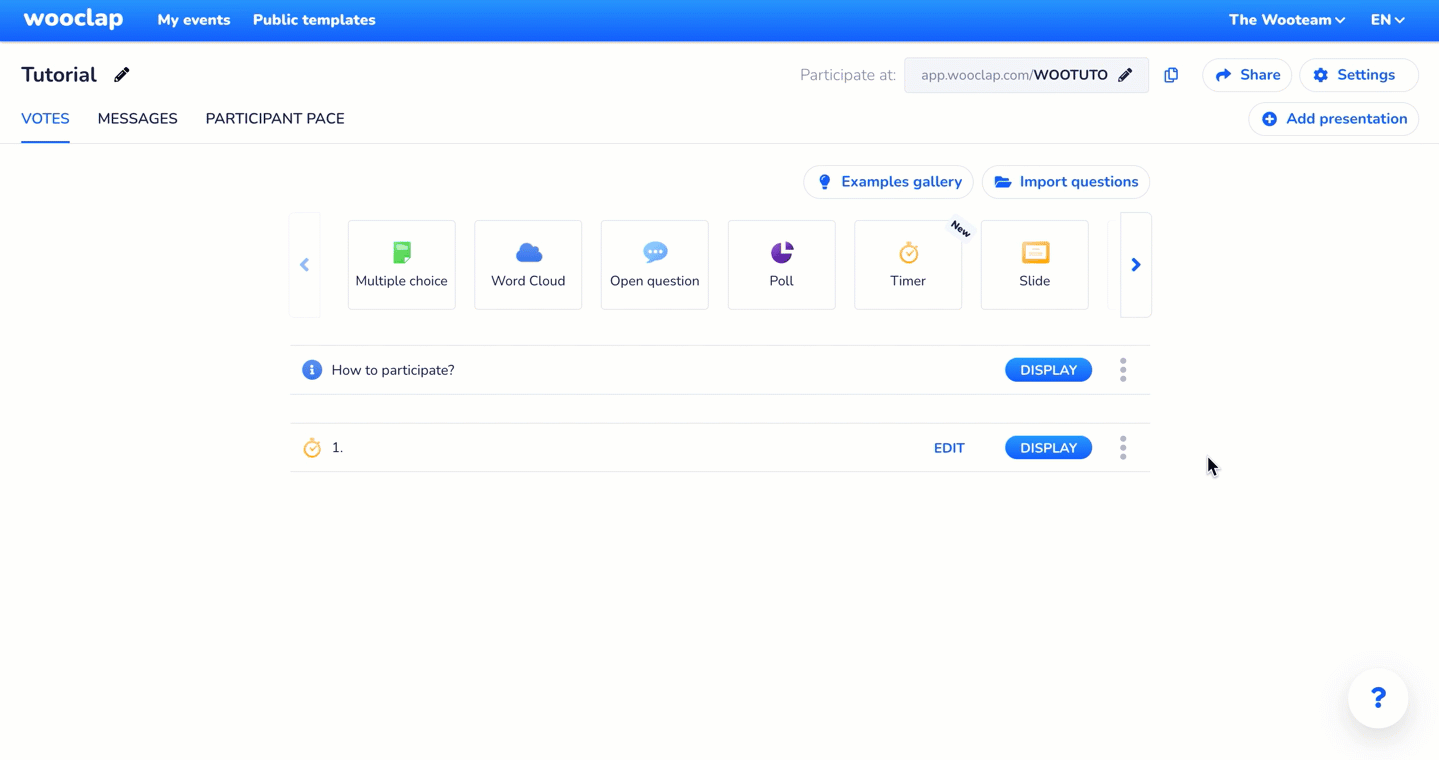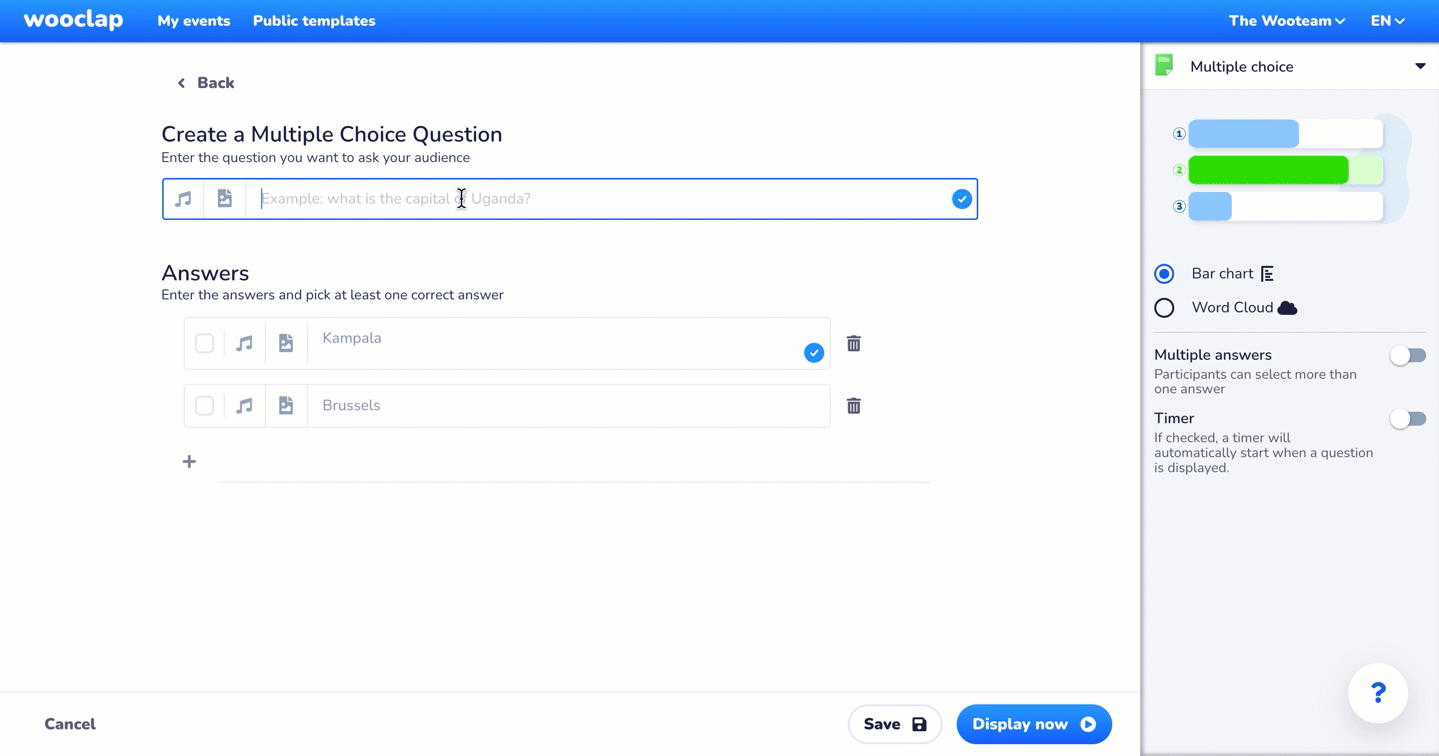
American summer tour! Wooclap will be at InstructureCon 2025
Come say hi at booth 41 from July 22nd to July 24th in Spokane, Washington
Top 7 interactive classroom games
03.01.2025 • 4 minutes

Among the various strategies available to make learning more dynamic and boost student engagement, games remain a particularly popular solution. After all, who hasn’t dreamed of having fun instead of studying? And who doesn’t love having fun? Of course, the point is not to replace the entire course content with playful activities (group games, interactive activities, fun content). On the contrary, it’s about finding games that complement the teacher’s message while providing a welcome break! A quick and easy way to step up your teaching game!
Ready to get your students playing (and why not, to play with them)? Here’s our selection of 7 interactive whiteboard games to try in the classroom.
The benefits of playing interactive classroom games
While there may seem to be a divide between playing and learning, experience shows that the two can go hand in hand. At home, for example, games and play sessions are not only essential for children’s development but also to help them learn certain concepts. So why not include them in some teaching strategies?
Bringing interactive games and activities into your classroom brings numerous benefits:
- Games help students (both kids and adults) develop specific skills such as memory, visualization, language proficiency, and applying subjects studied in class;
- By encouraging students to interact with one another and share their ideas, interactive games foster socialization, inclusion, and team spirit;
- Some students are more likely to fully engage, play an active role and push themselves to excel if the activity is part of a game;
- Games help students better understand and follow instructions while learning to respect rules (and having fun!).
Finally, it has been proven that the learning and memorization process works better when information is associated with an interesting or funny event. This highlights the importance of fostering classroom engagement through games and interactive activities!
Important: Before starting out a collaborative classroom project and introducing interactive games, it’s essential to select activities that align with the subject matter you are currently teaching. Games should serve to illustrate or deepen a concept, not replace its instruction!

No. 1: Last man standing
Last Man Standing is an interactive classroom game that allows testing students’ vocabulary within a specific subject matter (animals, grammar, objects from a specific historical era, anatomy, etc.). The game is played as follows:
- Participants form a circle;
- The first player says a word related to a previously defined category;
- The second player says a word from the same category, etc.;
- Players lose when they say a word that has already been said or when they run out of ideas and don’t know any other word.
Last man standing is perfect to revise lessons—especially vocabulary—in a fun way!
Our tip: choose a referee to determine whether the words said belong to the chosen category or not. You can also have a chronometer to prevent hesitant participants from wasting too much time (students should be relatively quick in giving their answer). Challenge your students. Who will win the game?

Use a minuter to prevent hesitant participants from wasting too much time
No. 2: Pictionary
Among the many interactive activities and games to do in the classroom, Pictionary is a timeless classic. Here’s how to play: a student picks a card with an object, animal, person, or concept. It could be anything: math, English, music, school, kids, reading, even time itself! They then have a limited amount of time to make the others (team members, or the rest of the class) guess what it is by drawing, without speaking or answering any questions. Drawing skills could play a part in this game.
In the classroom, drawing on paper is out of the question—it all happens on the whiteboard! You can spice up the game by creating your own cards and tailoring the Pictionary topics to subjects recently studied in class. Many online interactive tools can help you do this.

No. 3: Hangman
Time to focus on vocabulary by playing Hangman! This popular game in classrooms allows students to play and have fun while learning new vocabulary. It’s also a great opportunity to test knowledge acquired in previous weeks. You know how this game works: your students will have to guess the word before it’s too late!
No. 4: Observation game
Boost your students' memorization and descriptive skills with a simple observation game. How does it work? It’s easy! Place a set number of objects (start with around 20) on a table and allow students to observe them for a limited amount of time (a minute, for example). Then, cover the table with a cloth or board and ask students to describe one object at a time, taking turns. You can select objects related to the day’s lesson.
Variation: Were all the objects easily identified? Challenge your students further by asking them to provide as many details as possible about each object (shape, color, etc.).
No.5: The Timeline
What better way to revise history lessons than a good old timeline? The Timeline game is simple and easy to play:
- Draw a large timeline on the board;
- Give each student one or more cards with a historical event written on them, either related to the lesson or part of general knowledge;
- The first student places their event on the timeline in what they believe is the right position (if they don’t remember they simply guess);
- Taking turns, each student places their own card relative to the events already on the timeline;
- At the end, it’s time to check if the events are in the correct chronological order!
Variation: To make the Timeline game more challenging, ask each student to place their event on the timeline while specifying the exact date or at least the historical period it belongs to.
No. 6: The Wikipedia race
Do you have computers or tablets in your classroom? Start a Wikipedia Race! The goal of this interactive game is simple: all students start from the same Wikipedia page with the same instructions. They must reach a target page by clicking only on the hyperlinks within the Wikipedia articles. The first student to reach the target page wins!
This interactive classroom game helps improve students’ reading speed as well as the ability to deduce connections between different concepts (quick thinking is essential to win the game!).
No. 7: The quiz
If you add a bit of fun, originality and competition, a quiz can be a winner for your classroom games! Depending on the level and subject of the lesson, a customized quiz can serve multiple purposes:
- Introduce new concepts at the beginning of a class;
- Check the mood of a class;
- Test students' knowledge at the end of a lesson;
- Include a fun break during an especially intense class.
Whether it’s open-ended questions, multiple-choice questions (MCQs), polls, or scales, make sure to create your interactive quizzes using an online tool that offers a wide range of question types to avoid monotony! For quizzes that truly engage students, Wooclap is one of the essential technological tools to include in your classroom.
Now you should have a better idea of the best interactive games for your classroom! All you have to do is to select your interactive classroom tool, create your account and dive in!

Writer

The Wooclap team
Make learning awesome & effective
A monthly summary of our product updates and our latest published content, directly in your inbox.



